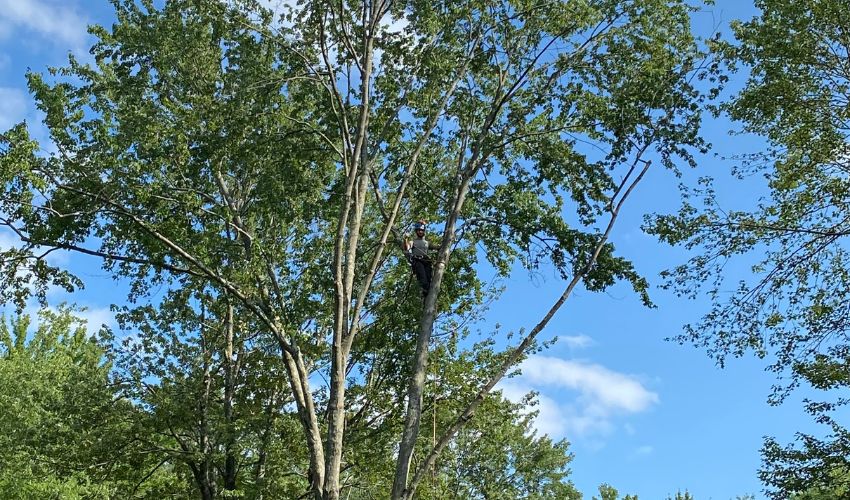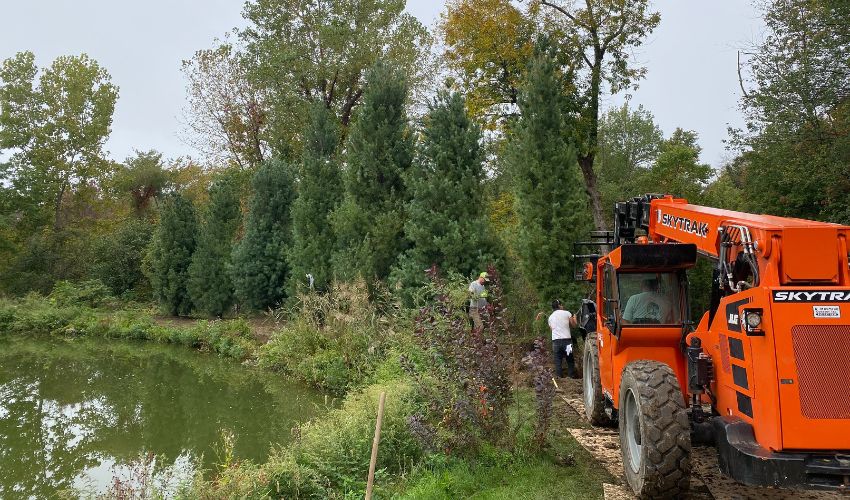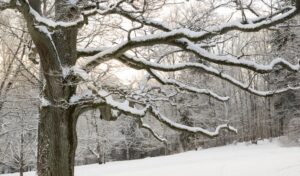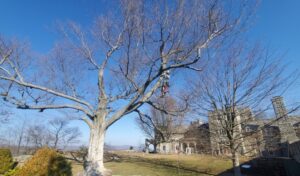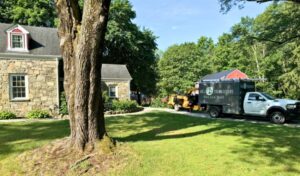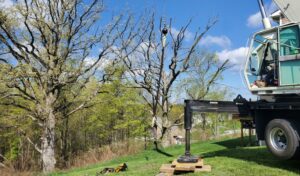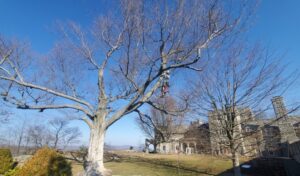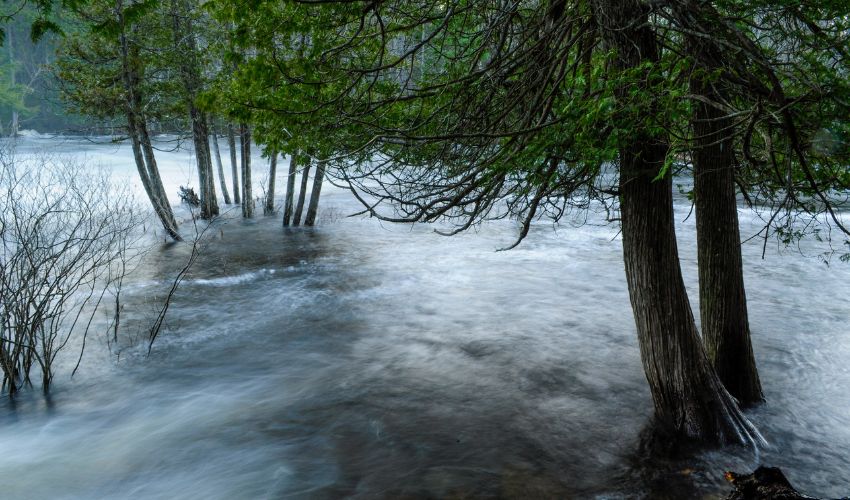
Floods can cause extreme damage to structures and properties, including your precious trees. Trees in flooded conditions can end up dead or unstable and put you at risk for further damage when not quickly addressed. Caring for flood-damaged trees is a delicate process that won’t always save them.
In this article, we will examine how best to care for flood-damaged trees. We’ll look at how often floods are a concern in the Hudson Valley, how they damage your trees, and what to do after the flood water has receded. With our tips, you may be able to help a flood-damaged tree recover and thrive again.
Key Takeaways
- The Hudson Valley is no stranger to destructive floods, with a massive one in 2023 causing damage across the region.
- Physical damage from floods includes broken branches, exposed roots, and damaged roots.
- Physiological damage to trees from floods involves the asphyxiation of roots from water and deposited soil.
- Helping a tree recover from flooding involves removing mulch, covering exposed roots, removing deposited soil, pruning broken branches, adjusting irrigation, and inspecting for bark damage.
- Consider planting flood-resistant tree species to lower the risk of flood damage to your trees during the next flood.
Flood Conditions in the Hudson Valley
Floods are not uncommon in the Hudson Valley, and they have had a knack for causing plenty of destruction. The Hudson Valley saw a historic flood in 2023 that left scars on the community. Some areas experienced nine inches of rain and extensive flooding within a few hours. Even a year later, residents still recovering.
The 2023 flood caused millions of dollars of damage across Orange County and the rest of the Hudson Valley. Many trees were killed or left heavily stressed as a result of the flooding. Aside from historic storms, flooding can still occur during periods of heavy rain, such as a flash flood in Dutchess County this past June.
Summer is the most common time for floods in the Hudson Valley, making recovery steps for a flood-damaged tree an essential part of your summer checklist after a flood.
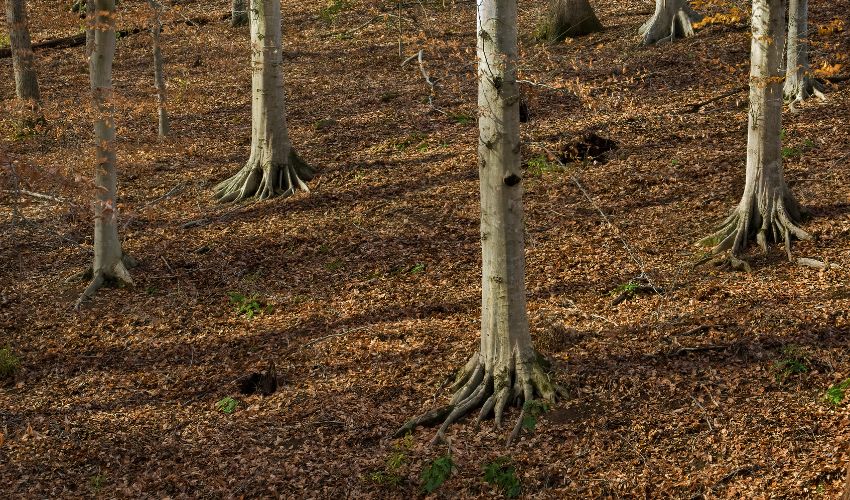
Exposed roots, like those demonstrated by the American beech trees pictured here, are a common sight after flooding.
How Floods Damage Trees
Floods damage trees in two primary ways: physically and physiologically.
Physical Damage to Trees from Floods
Physical damage from flooding includes things like broken branches, exposed roots, or damaged roots. A tree may have to deal with leaning or eroded soil after a flood. In general, physical damage is easier for a tree to recover from with your help. However, flooding can cause root rot, weakening the tree’s ability to stay anchored and making it more vulnerable to pests and diseases due to the added stress.
Physiological Damage from Flooding
Physiological damage occurs in two main forms: oxygen deprivation during flooding and soil deposits left behind afterward.
Roots are responsible for providing a tree with water, nutrients, and oxygen. During a flood, the roots cannot deliver oxygen for the rest of the tree, and most trees will use the existing oxygen in the soil in a few hours. During a flood, essential absorption roots (non-woody roots) will die.
The soil deposited from a flood will also starve the tree of oxygen after the flood waters recede. A tree’s roots may become buried by additional feet of soil made of sand or clay. This will kill some trees, though others can establish new roots closer to the surface. Deposited soil will also bury the root flare, further restricting oxygen and water penetration to the roots.
7 Tips to Help Your Tree Recover from Flood Damage
Now that you know how dangerous a flood can be for your trees, we can provide some tips to care for your trees when one occurs. Keep in mind that you likely won’t be able to do much for them until the water recedes.
WARNING: Always exercise caution around trees during and after a flood. Flooding and saturated soil can destabilize trees. Be sure to call a certified arborist to handle any work around hazardous trees.
1. Remove Any Soil or Sediment Build Up
Clear away any soil or debris from the tree’s root flare (where the trunk meets the roots). Hiring a professional arborist to remove newly deposited sediment and soil can help reduce the risk of oxygen deprivation and give your trees a better chance of survival.
2. Remove Mulch
Normally, mulch benefits trees by helping retain moisture within the drip line. However, after a flood, this is the opposite of what your tree needs. Remove any mulch around the tree to help the water in the soil evaporate more quickly.
3. Adjust Your Irrigation System
If you have an irrigation system set up to provide supplemental water to your trees, adjust it to avoid overwatering your trees after a flood. Overwatering your trees will cause excess stress that a tree can ill afford.
4. Prune Any Broken Branches
Low-hanging branches may end up broken or damaged from the flood waters. Pruning these branches will reduce stress in your tree and remove branches that may break off during a future storm. Although winter is usually the best time to prune in the Hudson Valley, there’s never a wrong time to remove broken branches.
5. Inspect Your Trees for Bark Damage
Floods can damage your tree’s bark, exposing the tree’s vascular system to the elements. If you notice damaged bark, contact an ISA Certified Arborist to examine the tree and see if there’s anything they can do to help it.
6. Cover Exposed Roots
Sometimes, flooding can remove soil from your tree rather than deposit more. When the flood erodes soil from around your tree, the roots may end up exposed. A tree with exposed roots will have lower stability, as its roots will not anchor it as well without soil.
These roots present a tripping hazard to you and a health hazard for the tree. Foot traffic and machinery can easily damage exposed roots, stressing the tree and making it more susceptible to insects and diseases.
Add soil around a tree if its roots are exposed, ensuring you do this before the roots dry out. Be careful not to apply too much soil, as this can suffocate the roots.
7. Remove Dangerous Trees
Unfortunately, not every tree can be saved after flood damage, and you may have to decide to remove a tree. Removing a dead or dying tree is dangerous and not something to handle yourself. Contact an arborist to handle your difficult tree removal.
Some Trees Are Flood Tolerant
Helping a tree recover from flood damage can be a long shot in many instances. If you are worried about your trees surviving floods, consider planting flood-resistant trees, such as:
- Red maple (Acer rubrum)
- River birch (Betula nigra)
- Overcup oak (Quercus lyrata)
- Silver maple (Acer saccharinum)
Hill Treekeepers Can Help Your Flood Damaged Trees
When a flood damages your trees, you need to act fast to have a chance at saving them. Helping the roots recover by covering exposed areas with soil, removing excess soil deposited by the flood, and removing mulch can improve their chances of survival. Other essential techniques are to prune any broken branches, determine any bark damage, and adjust your irrigation.
At Hill Treekepers, we can assist you after a flood and give you an honest appraisal of what to do for your trees. We’ll suggest techniques we believe might save the tree, or we will recommend removal if we don’t see any other options.
Don’t wait to get help with your flood-damaged trees. Call us today at 914-214-7045 or request a quote online to get started.
Share this online!
Get the highest quality of tree services for residential and commercial properties in the Hudson Valley area. We look forward to working with you!
TOPICS
Recent Articles
Don't Miss the Next Update!
Join the thousands of smart Hudson Valley residents who get the monthly newsletter from Hill Treekeepers. It's full of helpful information you won't want to miss!

